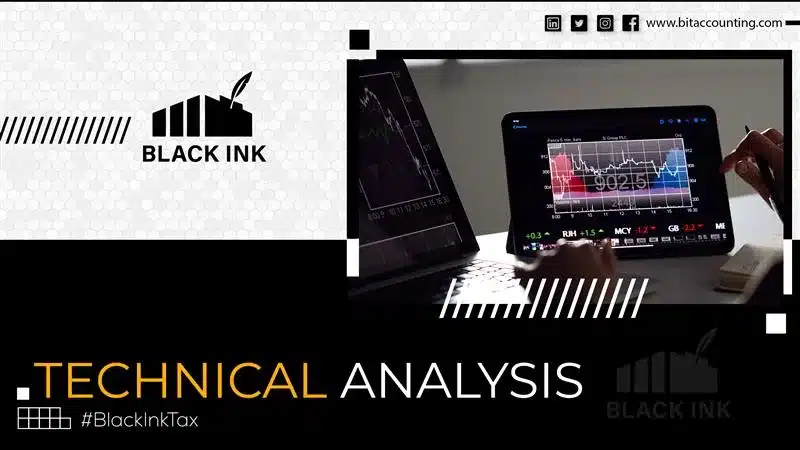
Table of Contents
Technical Analysis of the Financial Markets: A Complete Guide
Imagine trying to understand the stock market without reading news articles or studying company reports. Sounds strange, right? But that’s exactly what technical analysis helps you do. It’s a method that uses charts, prices, and patterns to help people make smart trading choices.
Whether you’re a beginner curious about stocks, a trader diving into financial data analysis, or someone in the business world looking to improve your investment decisions — this guide is for you. We’ll break down technical analysis into easy pieces, so you can start using it confidently in your financial markets journey.
In this guide, we’ll explore how technical analysis works, how it’s different from fundamental analysis, and why it’s such a powerful tool in the world of investing.
What is Technical Analysis?
At its core, technical analysis is the study of price and volume data from past market behavior. It’s based on one main belief: “The price reflects everything.” That means the current price already includes all public information — news, earnings, even investor emotions like fear or optimism.
Instead of focusing on a company’s balance sheet or its value, technical analysis looks at:
- Price trends
- Chart patterns
- Volume movements
- Market sentiment
It works because human behavior in the financial market often repeats itself. Traders respond to patterns in similar ways — and those reactions leave clues in the charts.
History of Technical Analysis
Technical analysis has roots going back centuries. It began with Charles Dow, the father of the Dow Theory, who believed that market trends could be studied through charts and averages. Around the same time, in Japan, rice traders created candlestick charts — a method still used today.
Over time, as technology improved, so did technical analysis. Now, with algorithmic trading, AI tools, and fast data analysis, we can analyze price patterns in seconds. Tools like Moving Averages, MACD, and Bollinger Bands are common in today’s financial services.
Technical vs. Fundamental Analysis
Let’s break down the difference.
Technical Analysis | Fundamental Analysis |
Focuses on charts, trends, and price action | Focuses on company earnings, economy, and industry health |
Looks at past behavior | Looks at intrinsic value (finance) |
Best for short-term trading | Better for long-term investing |
You don’t have to choose just one. Many investors combine both methods to make better decisions — looking at financial data and price charts side by side.
Advantages and Limitations of Technical Analysis
Here are benefits and drawbacks of technical analysis:
Pros of Technical Analysis
- Works in all markets: Stocks, commodities, cryptocurrencies, and foreign exchange market — TA applies to all.
- Real-time insights: Helps spot trading opportunities quickly.
- Flexible and visual: Great for pattern recognition.
Cons of Technical Analysis
- Subjective: Different people may read charts differently.
- Can give false signals: Not all patterns lead to real price moves.
- Depends on past data: It doesn’t always predict the future.
That’s why combining it with good risk management and some basic economic forecasting is key.
Core Concepts of Technical Analysis
The following are the core concepts of technical analysis:
Price Charts: The Foundation
Everything in technical analysis begins with charts. Here are the main types:
- Line charts – Simple and easy to read.
- Bar charts – Show opening, closing, high, and low prices.
- Candlestick charts – Most popular; they display price action clearly.
- Timeframes – From 1-minute charts for day trading to monthly charts for long-term investment.
Market Trends and Their Importance
Trends show where the market is heading:
- Uptrend: Higher highs and higher lows
- Downtrend: Lower highs and lower lows
- Sideways trend: No clear direction
Spotting the right market trend helps you trade with the flow, not against it.
Support and Resistance Levels
Think of support as a floor where prices often bounce up and resistance as a ceiling where prices usually stop climbing. These levels help traders decide:
- When to enter a trade
- Where to set stop-losses
- When to take profits
Sometimes, support becomes resistance and vice versa — a phenomenon known as role reversal.
Volume Analysis
Volume shows how many shares or contracts are being traded. It matters because:
- High volume confirms trends
- Volume spikes often signal strong moves
- Low volume might mean a weak trend
Volume tells us how much attention a price move is getting.

Key Technical Indicators and Tools
Explore some important technical indicators and tools:
Trend-Following Indicators
- Moving Averages: Show average price over a period.
- MACD: Signals trend changes.
- ADX: Measures trend strength.
Momentum Indicators
- RSI: Tells if a stock is overbought or oversold.
- Stochastic Oscillator: Tracks momentum and reversals.
- Williams %R: Similar to RSI but faster.
Volatility Indicators
- Bollinger Bands: Show when prices are too high or low.
- ATR: Measures how much price moves on average.
Volume-Based Indicators
- OBV (On-Balance Volume): Links volume to price movement.
- VWAP: Tells average price weighted by volume.
Chart Patterns
- Reversal patterns: Head and Shoulders, Double Top/Bottom
- Continuation patterns: Flags, Pennants, Triangles
These patterns help traders forecast what might come next — a key part of forecasting in the stock market.
Advanced Technical Analysis Techniques
Now, let’s understand some high-level technical analysis techniques:
Fibonacci Retracement and Extensions
These levels (23.6%, 38.2%, 61.8%) help traders:
- Find pullback areas
- Set entry or exit points
Elliott Wave Theory
This theory says markets move in waves. You get 5 impulse waves in one direction and 3 corrective waves in the opposite direction. It’s popular among those studying market behavior and psychological concepts.
Ichimoku Cloud
A complex but powerful system that shows support/resistance, trend direction, and strength all in one chart.
Multiple Time Frame Analysis
Looking at a stock on multiple timeframes (daily, weekly, etc.) gives stronger signals. Long-term charts show the big picture, while short-term ones help with timing.
Algorithmic and AI-Based Technical Analysis
With machine learning and automation, modern TA tools can scan thousands of stocks in minutes. This is where financial technology meets science, cognition, and behavioral economics.
Building a Trading Strategy with Technical Analysis
Let’s understand how to build best strategy with technical analysis:
Steps to Develop a Trading Plan
- Set your goals and risk tolerance
- Pick a trading strategy (trend-following, momentum, etc.)
- Choose your indicators wisely
Entry and Exit Strategies
Good exit strategies help you:
- Enter at the right time
- Exit before losses grow
- Lock in profits
Using tools like MACD, RSI, or Bollinger Bands can boost decision-making.
Risk Management in Technical Trading
- Use proper position sizing
- Keep a solid risk-to-reward ratio
- Avoid emotional decisions like revenge trading
Backtesting and Optimization
Before using a strategy live, test it on past data. Platforms like TradingView and MetaTrader help you do this easily.
Common Mistakes to Avoid
- Using too many indicators (clutter)
- Ignoring the economy or fundamentals
- Trading based on emotion or market hype
Practical Applications of Technical Analysis
Here are some practical applications of TA:
Technical Analysis in Different Markets
It works not just in stocks, but also:
- Forex (currency trading)
- Cryptocurrencies
- Commodities like gold or oil
Case Studies
- In 2020, Bitcoin broke through a major resistance line — traders using TA predicted the breakout early.
- During 2008, many stocks showed signs of weakness before the crash, seen in volume and price action.
Combining Technical Analysis with Other Methods
- Mix TA with fundamental analysis for better results.
- Add sentiment tools (like social media or news buzz) to track how traders feel.
Conclusion
Technical analysis is more than just lines and numbers — it’s a way to understand how people behave in the market (economics). By reading charts, patterns, and volume, traders can make smarter, faster choices.
From beginners to financial analysts, this method helps everyone stay sharp in a fast-moving world. So whether you’re trading equity securities, diving into derivatives (finance), or just watching the stock exchange, knowing technical analysis gives you an edge.
This guide was brought to you by BIT Accounting, where learning meets smart business decisions.
FAQs
1: Can beginners use technical analysis?
Yes! With basic knowledge and practice, even beginners can use it for better investment choices.
2: Is technical analysis only for day traders?
No — it works for all styles, including long-term investing.
3: Does technical analysis guarantee profits?
No strategy is perfect. But TA helps you make informed decisions, reduce emotion, and manage risk.
4: Can technical analysis work in the real economy?
Yes — even though it focuses on charts, it reflects how supply and demand, fear, and psychology affect price.
5: How do I get started with technical analysis?
Start with simple charts, learn to spot trends, and practice with a demo account or paper trades.
GET FREE QUOTE FOR ALL OF OUR SERVICES
Black Ink will send you a free analysis of your current state and what would be the cost of managing either a separate accounting and bookkeeping services or a complete solution across New York, USA. Do get in touch and we will be happy to consult you with our bookkeeping services in NY, New York, USA.
